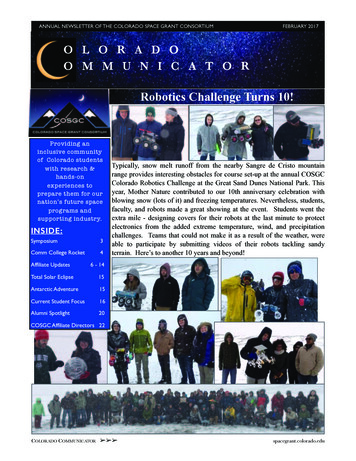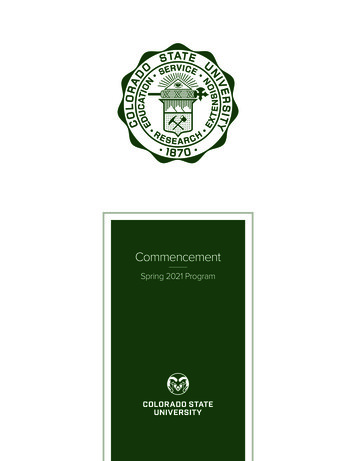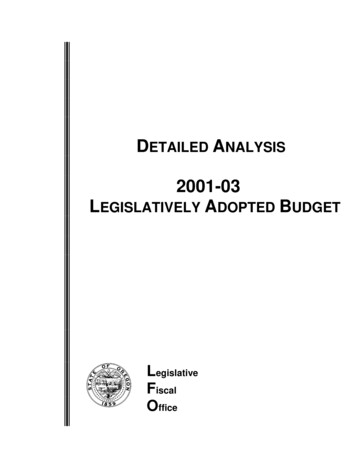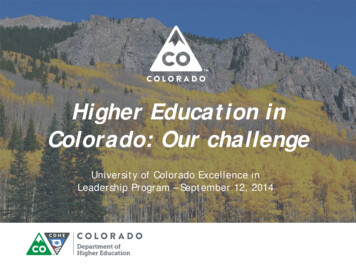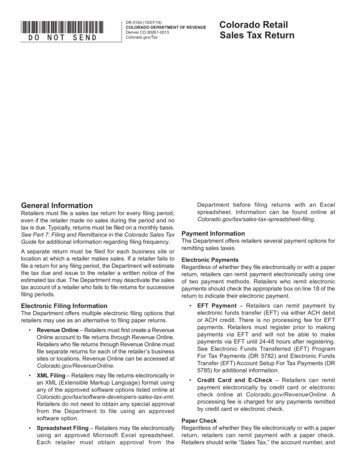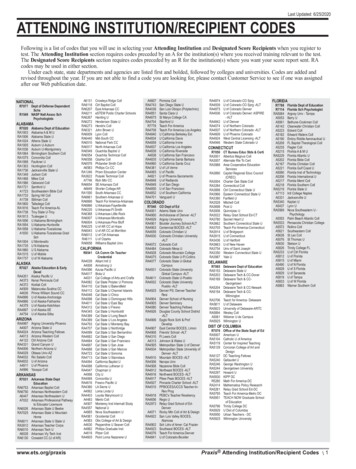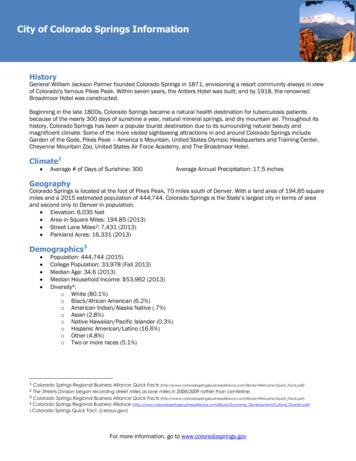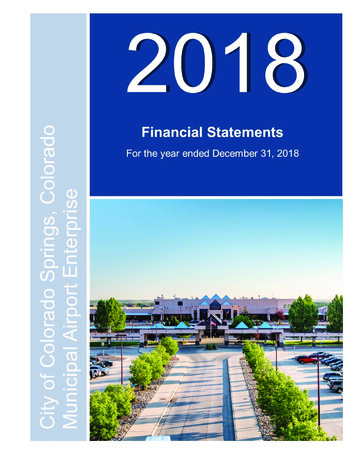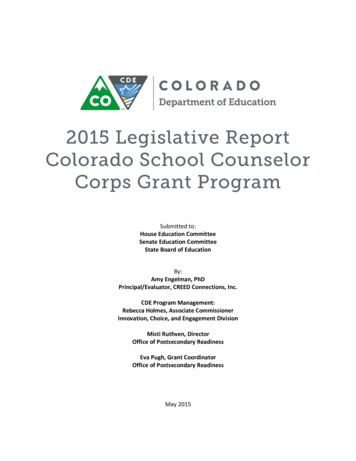
Transcription
2015 Legislative ReportColorado School CounselorCorps Grant ProgramSubmitted to:House Education CommitteeSenate Education CommitteeState Board of EducationBy:Amy Engelman, PhDPrincipal/Evaluator, CREED Connections, Inc.CDE Program Management:Rebecca Holmes, Associate CommissionerInnovation, Choice, and Engagement DivisionMisti Ruthven, DirectorOffice of Postsecondary ReadinessEva Pugh, Grant CoordinatorOffice of Postsecondary ReadinessMay 2015
2015 Legislative Report Colorado School Counselor Corps Grant Program2015 Colorado State Board of Education MembersMarcia Neal (R)3rd Congressional DistrictJane Goff (D)7th Congressional DistrictValentina Flores (D)1st Congressional DistrictAngelika Schroeder (D)2nd Congressional DistrictPam Mazanec (R)4 Congressional DistrictthDebora Scheffel (R)6 Congressional DistrictthSteve Durham (R)5 Congressional DistrictthRobert HammondCommissioner of Education201 East Colfax Avenue, Room 506Denver, Colorado 80203www.cde.state.co.us2
2015 Legislative Report Colorado School Counselor Corps Grant ProgramTable of ContentsExecutive Summary4SCCGP Cohort 2SCCGP Cohort 2, Year 3 OutcomesSCCGP Cohort 2, Year 3 Grantee ImplementationConclusionIntroduction6Purpose of the ProgramRole of the School Counselor Corps Advisory CommitteeDescription of Program for Reporting Period July 1, 2013 to June 30, 20146Grant Application ProcessDescription of GranteesData Collection and Analysis12Comparison GroupSCCGP Cohort 2, Year 3 Outcomes13Graduation RatesDropout RatesAttendance RatesConcurrent EnrollmentFree Application for Federal Student Aid (FAFSA)Postsecondary MatriculationSCCGP Cohort 2, Year 3 Grant Implementation19Progress Toward Grantee GoalsProfessional DevelopmentIndividual Career and Academic Plan (ICAP) ImplementationStudent-to-Counselor RatiosAmerican School Counselor Association’s National Model ImplementationCareer and Technical EducationCollege VisitsConclusion23Attachment A: 2013-14 School Counselor Corps Advisory Committee25Attachment B: Data Collection Analysis and Process263
2015 Legislative Report Colorado School Counselor Corps Grant Program4Executive SummaryThe School Counselor Corps Grant Program (SCCGP) became part of the Colorado Revised Statute in 2008 (2291-101 et. seq.) in order to increase the availability of effective school-based counseling within secondaryschools. The purpose of SCCGP is to increase the graduation rate within the state and increase the percentage ofstudents who are appropriately prepared for, apply to, and continue into postsecondary education. SCCGPallocates funding for a three-year grant cycle. This report describes SCCGP Cohort 2 grantees and their third yearof outcomes for the July 1, 2013 to June 30, 2014 reporting period.SCCGP Cohort 2SCCGP Cohort 2 consists of 23 grantees funding a total of 75 secondary schools. Eighteen grantees were districtsand five were charter schools spanning diverse regions of the state. These schools served 44,489 students, 64percent of whom qualified for free or reduced lunch on October 1, 2013. The students being served throughSCCGP Cohort 2 also have highly diverse ethnic backgrounds with 68 percent identifying with an ethnic minoritybackground as compared to 45 percent of students across the state. Additionally, these students experience ahigher rate of mobility (22 percent) than the state (16 percent).SCCGP Cohort 2, Year 3 OutcomesSince 2009-10, the statewide on-time graduation rate for Colorado had increased an average of 1.5 percentagepoints annually until this past year, which realized an additional half percentage point increase with the Class of2014, reaching a statewide rate of 77.3 percent. SCCGP Cohort 2 realized a similarly positive trend with a moreprofound rate of improvement than the state average over the course of the five years. SCCGP Cohort 2 hasrealized a 7.8 percentage point gain whereas the comparison group only 5.8 percentage points. While all groupsare making improvements, SCCGP Cohort 2 is making greater strides at closing the achievement gap forgraduation rates. Sixty-five percent of the Class of 2010 from SCCGP Cohort 2 graduated whereas 72.5 percentof the cohort’s Class of 2014 graduated.In 2008-09, prior to SCCGP funding, Cohort 2 schools had an annual dropout rate of 5.5 percentage pointswhereas the state’s rate was 5 percentage points. At the end of three years of SCCGP funding, the Cohort 2schools closed the achievement gap with an average dropout rate the same as the state average, 3.5 percentagepoints. The SCCGP Cohort 2 schools reduced the dropout rate twice as much as the state (a 2 percentage pointreduction) resulting in 372 fewer dropouts over the three years. The comparison schools had less significant of arate of change than both the SCCGP Cohort and the state, lowering from 5.2 to 3.9 percentage points.During the third year of funding, 39 SCCGP Cohort 2 high schools engaged 1,742 students in ConcurrentEnrollment, which was nearly a 74 percent increase from the first year. During this same period, the staterealized a 30 percent increase, and the comparison group saw a 48 percent gain. SCCGP Cohort 2 schoolssignificantly increased their students’ participation in Concurrent Enrollment as compared to the state and thecomparison group.Postsecondary matriculation data for year one illuminated a significant increase in students enrolling in collegeafter the first year of SCCGP funding from 31 percent to 44 percent. SCCGP Cohort 2 schools continued to closethe gap between their rate and the state’s steady rate of 57 percent by reaching 46 percent after year two. Datafor year three were not yet available at the time of report submission.
2015 Legislative Report Colorado School Counselor Corps Grant Program5SCCGP Cohort 2, Year 3 Grant ImplementationOverall, grantees are making progress toward their grant goals. In these cases, grantees are identifyingstrategies for improvement through the use of data and support that the SCCGP provides. Grantees benefitedfrom direct access to a total of 3,600 hours of postsecondary workforce readiness (PWR) professionaldevelopment, with more than 325 school professionals accessing an average of 11 hours of training on PWRthrough SCCGP. Additionally, SCCGP school counselors engaged in more than 10 hours of interactiveprofessional development, focused on best practices in identifying achievement gaps and making data-drivendecisions. These additional hours were funded directly by the SCCGP.Pursuant to SB 09-256, all schools are required to have Individual Career and Academic Plans (ICAP) for eachstudent, grades ninth through twelfth. Grantees reported on their progress with this postsecondary workforcereadiness strategy noting how the school counselors were instrumental in quality, comprehensiveimplementation.SCCGP funding successfully reduced student-to-counselor ratio in cohort schools from 363:1 prior to funding to229:1 in the third year, which is well below the American School Counselor Association’s (ASCA) recommendedmaximum rate (250:1). Grantees and schools report how critical SCCGP funding is to having the capacity toimplement a quality school counseling program.Overall, SCCGP Cohort 2 schools have partially implemented school counseling programs with an overall ASCANational Model implementation score of 3.2 (on a four point scale with 4 fully implemented). The followingare areas on which to focus continued improvement and support: School Counseling priorities on curriculumand education committees (2.6) and implementing regular needs assessments to guide programming (2.7). Theattention that SCCGP program staff has given to professional development addressing analyzing data bydemographic variable to identify interventions to close achievement gaps is beginning to show impact in selfreported implementation scores increasing from 2.7 to 3. Analyzing the individual components, schools areexcelling at spending at least 80 percent of school counselors’ time on activities that directly benefit students(3.6); organizing services so that all students are well served and have access to them (3.5); designinginterventions to improve the school’s ability to educate all students to high standards (3.4); and using studentperformance data to decide how to meet student needs (3.4).
2015 Legislative Report Colorado School Counselor Corps Grant Program6IntroductionHouse Bill 08-1370 established the School Counselor Corps Grant Program. The resulting legislation enacted bythe General Assembly is 22-91-101 et. seq., of the Colorado Revised Statutes (C.R.S.). The State Board ofEducation promulgated rules for program implementation, including: the timeline for submitting applications tothe Department, the form of the grant application, criteria for awarding grants, and any information to beincluded in the Department’s program report. Effective September 30, 2008, these rules can be found at 22-91101 et. seq. (C.R.S.).Purpose of the ProgramThe purpose of the School Counselor Corps Grant Program (SCCGP) is to increase the availability of effectiveschool-based counseling within secondary schools with a focus on postsecondary preparation. SCCGP wascreated to increase the graduation rate and increase the percentage of students who appropriately prepare for,apply to, and continue into postsecondary education. The role of school counselors has undergone revisions andchanges, and today the emphasis is on college and career readiness and ensuring timely high school graduation.Among the reasons for this shift is that a high percentage of students either are not graduating on-time (withinfour years of entering ninth grade) or not graduating. i Timely monitoring, evaluating, and intervening arenecessary measures to decrease the number of students who dropout and increase the number of students whograduate. ii SCCGP supports school counselors in implementing these types of activities.Role of the School Counselor Corps Advisory CommitteeThe School Counselor Corps Advisory Committee assists the Department in providing ongoing support to thefunded sites in the form of professional development, mentoring, site visits, and technical assistance. SeeAttachment A for a listing of School Counselor Corps Advisory Board members.Description of Program for Reporting Period July 1, 2013 – June 30, 2014Grant Application ProcessThe Request for Proposal (RFP) was announced in the spring of 2011 prior to the State Legislature making finalappropriations to the program in order for eligible education providers to have time to prepare application tothe program. This allowed the funds to be maximized by beginning implementation at the start of the newschool year. The available funding for the launch of the second SCCGP cohort in the 2011-2012 school year was 4,800,000, 4,320,000 for 2012-13, and 3,928,650 for 2013-14. The SCCGP design reduces funding by 10percent annually over the course of three years in order to encourage grantees to systematize and sustainprogramming beyond the grant program.SCCGP defined an eligible education provider as: A school district (on behalf of one or more secondary schools); A Board of Cooperative Services (BOCES); A charter school; or An Institute Charter School.Priority was given to applicants that serve: Secondary schools at which the dropout rate exceeds the statewide average; and/or Secondary schools with a percentage of students who are eligible for Free or Reduced Lunch exceedingthe statewide average.
2015 Legislative Report Colorado School Counselor Corps Grant Program7Allowable activities included secondary school counselor salaries and benefits; postsecondary preparatoryservices; and professional development. The RFP included a rubric that detailed criteria that a proposal would bemeasured against and included sections on 1) a quality plan, 2) partnerships, 3) postsecondary activities, and 4)a budget narrative.Description of GranteesSCCGP Cohort 2 consists of 23 grantees. In the two initial years, 76 schools were funded. However, after the2012-13 school year, Wasson High School in Colorado Springs District 11 closed. Eighteen grantees are districtsand five are charter schools. SCCGP grantees represent a wide range of schools serving a diverse studentpopulation with regard to secondary school type, student count, mobility rates, geographic region, ethnicity, andfree and/or reduced lunch qualified students.Type of Secondary School: Thirty-three of the 75 SCCGP funded schools are high schools. An additional 12serve both middle and high school grade levels. The remaining 30 are middle schools. Table 1, on page 9,outlines the grantees and the secondary grade levels served by the schools funded. iii Eleven of these schools aredesignated Alternative Education Campuses (AEC).Geographic Location: As depicted in the map below, SCCGP Cohort 2 grantees are located across Colorado.MAP 1: SCCGP Cohort 2 Grantees’ Location
2015 Legislative Report Colorado School Counselor Corps Grant ProgramMAP 2: SCCGP Participating Districts from 2008-20158
2015 Legislative Report Colorado School Counselor Corps Grant ProgramTABLE 1: SCCGP Cohort 2 Grantees and Types of Schools FundedHighMiddleUndivided Middle & HighTotalAdams 12 Five Star Schools3003Adams County 142204Adams-Arapahoe 28J0707Boulder Valley RE 22002Center 26 JT2103Cherry Creek 51304Colorado Springs 113519Cripple Creek-Victor RE 10011Denver County 143310Greeley 63003Harrison 22507Jefferson County R-14004Karval RE-230022Mapleton 11012Mesa County Valley 513003Moffat 20011Montezuma-Cortez Re-11001Poudre R-10314Ace Community Challenge School0011Animas High School1001Atlas Preparatory School0101Colorado Springs Early Colleges1001High Point Academy0011TOTAL33301275DistrictsCharter Schools9
2015 Legislative Report Colorado School Counselor Corps Grant Program10Student Count and End of Year Pupil Membership: At the time of the official student count in October of2013, the 75 SCCGP Cohort 2 schools had 44,489 students enrolled in grades 7-12. Despite one SCCGP fundedschool closing, nearly the same number of students was served through the grant. Over the course of the year,SCCGP Cohort 2 schools served 56,269 students grades 7-12 in 2013-14, which is also roughly the same as in theprior year. (Note: The majority of data described throughout the report utilizes End of Year pupil membership,because it takes into consideration the students who are transient during the course of the year and, therefore,provides a more accurate base count.)Mobility: CDE defines student mobility rates as the unduplicated count of grade K-12 students who moved intoor out of the school or district in a given year divided by the total number of students that were part of the samemembership base at any time during the same year. In 2012-13, the calculation was changed to excludestudents who changed districts during the summer, whereas in prior years only students who just changedschools within the same district were excluded. The following chart illustrates 2012-13 and 2013-14 mobilityrates for SCCGP Cohort 2 as compared to the state for grades 7-12. This comparison illuminates that the SCCGPCohort 2 population is highly mobile (22%) compared to the state (16%) and also suggests that SCCGP Cohort 2schools are showing signs of retaining more of their students, which could be in part due to this grant program.CHART 1: SCCGP Cohort 2 Mobility Rates, 2012-13 & 2013-1425%Mobility Rate20%15%SCCGPState10%5%0%2012-132013-14
2015 Legislative Report Colorado School Counselor Corps Grant Program11Ethnicity: The students being served through SCCGP Cohort 2 have highly diverse ethnic backgrounds. 68percent of SCCGP Cohort 2 students identify with an ethnic minority background as compared to 45 percent ofstudents across the state. The following chart depicts the breakdown of students’ ethnicities in SCCGP fundedschools for 2013-14. Little to no change was observed from prior years. (Note: only 159 Native Hawaiian andPacific Islander students were served in this cohort; therefore, their representation of less than 1 percent wastoo small to include in the chart.)CHART 2: Students’ Ethnicity in SCCGP Cohort 2 Schools, 2013-141%Am. Indian or Alaskan Native3% 3%11%32%AsianBlackHispanicWhite49%Two or More RacesFree or Reduced Lunch: The number of students qualifying for free or reduced lunch is the standard proxyfor students’ socioeconomic status and, as such, one of SCCGP’s eligibility requirements is that the schools servea high percent of students qualifying for free and reduced lunch. This year’s report utilizes October count data assome of the district’s End of Year data for free or reduced lunch contained systemic errors. As of October 1,2013, 64 percent of the 44,489 students served in SCCGP funded schools qualified for free or reduced lunch. Forcomparison, 38 percent of all Colorado students in grades 7-12 qualified for free or reduced lunch. Thus, SCCGPcontinues to successfully target students who are economically disadvantaged.TABLE 2: SCCGP Cohort 2 Percentage of Students Grades 7-12 Qualifying for Free or Reduced Lunch, 2013-14(Based on October 1, 2013 Pupil Count)SCCGP Cohort 2StateStudents Grade 7-12 Qualifyingfor Free or Reduced Lunch28,419144,94944,489Students Qualifying forFree or Reduced Lunch63.9%378,00838.4%Students Grades 7-12
2015 Legislative Report Colorado School Counselor Corps Grant Program12Data Collection & AnalysisA variety of data sources were utilized for this report. Wherever possible, third-party validated data sourceswere used as a primary source, such as the National Student Clearinghouse or U.S. Department of Education, asthese data have been verified as accurate by a third party entity. When this type of data were unavailable, statecollected data were utilized. Additionally, grantees and schools submitted a year-end annual report during thespring semester to illuminate program implementation for year three. In addition to examining trends and statecomparisons where possible, a quasi-experimental design was utilized with a comparison group comprisingschools that are similar to SCCGP Cohort 2 funded schools. (For more analysis details, See Attachment B.)Comparison GroupAs indicated by demographic data outlined in the previous section, SCCGP schools are a unique subset within thestate. Therefore, a comparison group of schools was pulled from the list of schools that were eligible for fundingbased on their 2008-09 dropout rate or percentage of students qualifying for free or reduced lunch. (Comparingthe cohort schools to all schools shows useful data but does not compare these schools to similar schools interms of demographics or history of outcomes.) Schools that were funded by SCCGP in Cohort 1 were excluded,which limited the number of large high schools available for comparison. Schools were selected based upon2008-09 data on their dropout rate, percentage of students qualifying for free or reduced lunch, grade levelsserved, student body size, and school type (e.g. Alternative Education Campus designation, charter). A numberof schools had closed or reconfigured since their eligibility was determined in 2008-09 and, therefore, wereeliminated from the final comparison group. The following table describes the composition of SCCGP Cohort 2,its comparison group, and the state on key variables from 2008-09 when eligibility was determined.TABLE 3: SCCGP Cohort 2 and Comparison Group Grades 7-12 Composition, 2008-09*SCCGP Cohort 2Comparison GroupState TotalsTotal Number of SchoolsTotal Pupil Count (EOY Membership)Grades 9-12 Pupil CountGrades 7-8 Pupil 6,953282,657134,296Students in grades 9-12Students in grades 7-8Students in AEC schools**Students Econ. .7%29.8%9th-12th Grade Dropout Rate7th-8th Grade Dropout Rate5.5%1.2%5.3%1%5%0.7%*Baseline data prior to grant funding**AEC designation is an estimate as schools designations are non-permanent.This comparison group is utilized throughout the report when analyzing third-party validated and state-collecteddata. The only significant change to the comparison group was that at the end of 2012-13, Fairview K-8 closed.
2015 Legislative Report Colorado School Counselor Corps Grant Program13SCCGP Cohort 2, Year 3 OutcomesPostsecondary Workforce Readiness (PWR) was defined and jointly adopted by the State Board of Education andColorado Commission of Higher Education in June of 2009. PWR describes “the knowledge, skills, and behaviorsessential for high school graduates to be prepared to enter college and the workforce and to compete in theglobal economy including content knowledge, learning and behavior skills.” Districts operationalize PWR in avariety of ways, including students having the required life skills for success after high school, GPAs, on-track toon-time graduation, having work experience and/or college credit. This report highlights third-year outcomesand baseline data for the following indicators: Graduation rate Dropout rate Attendance rate Concurrent enrollment participation Free Applications for Federal Student Aid (FAFSA) completion Postsecondary matriculationGraduation RatesSCCGP aims to increase grantees’ on-time graduation rate. This analysis begins with the Class of 2010 when thefour-year formula was adopted so that a trend can be established. The revised formula defines “on time” as onlythose students who graduate from high school four years after transitioning from eighth grade. Since the reviseddefinition has been in place, the graduation rates for Colorado had increased 1.5 percentage points annuallyuntil this past year which only realized a 0.4 percentage point increase with the Class of 2014, reaching astatewide rate of 77.3 percent. SCCGP Cohort 2 realized a similarly positive trend with a more profound rate ofimprovement than the state average over the course of the five years. The comparison group started out with asimilar rate to SCCGP Cohort 2; however, SCCGP Cohort 2 has realized a 7.8 percentage point gain over the fouryears whereas the comparison group gained only a 5.8 percentage points. While all groups are makingimprovements, SCCGP Cohort 2 is making greater strides at closing the achievement gap. The following chartdisplays these trends.CHART 3: On-time Graduation Rates for SCCGP Cohort 2 (Classes 2010 – 2014)80%4-Year Graduation P55%Comparison50%Class of 2010 Class of 2011 Class of 2012 Class of 2013 Class of 2014Note: SCCGP funds began the 2011-12 academic year.
2015 Legislative Report Colorado School Counselor Corps Grant Program14Dropout RatesDropout rate analysis begins with the 2008-09 school year as these data were part of the eligibility criteria. Overthe five school years within this analysis, the statewide dropout rate improved, or declined, from 5 percent to3.5 percent for grades 9-12. In 2008-09, SCCGP Cohort 2 schools had a 5.5 percent dropout rate. After threeyears of funding SCCGP Cohort 2, the SCCGP Cohort achieved the same dropout rate as the state, 3.5 percent.The comparison group’s rate remained higher at 3.9 percent despite having started out slightly lower thanSCCGP Cohort 2. In three years, SCCGP Cohort 2 schools have closed the achievement gap with respect to theirdropout rates as compared to the state.Annual Dropout Rate (9th-12th grades only)CHART 4: Grades 9-12 Dropout Rates for SCCGP Cohort 2 (2008-09 through 013-14Note: SCCGP funds began the 2011-12 academic year.
2015 Legislative Report Colorado School Counselor Corps Grant Program15The SCCGP Cohort 2 dropout rate reduction retained an additional 371 dropouts assuming that the Cohort’s rateremained the same as in 2010-11, prior to funding.CHART 5: SCCGP Cohort 2 Dropouts Retained Over the First Three Years of FundingAttendance RatesGraduation rates do not apply to middle schools and dropout rates at the middle school level are below onepercent making meaningful change difficult to observe. Therefore, attendance rates are utilized as an additionalindicator or proxy for school connectedness and future completion at the middle school level. All groupsfollowed a similar trend in attendance in the past few years; and although slightly lower than the state average,SCCGP Cohort 2 maintains a slightly higher attendance rate than the comparison group.CHART 6: Aggregated Attendance Rates for SCCGP Cohort 2, Middle Schools (2009-10 through 2013-14)96%Aggregated Attendance Note: SCCGP funds began the 2011-12 academic year.
2015 Legislative Report Colorado School Counselor Corps Grant Program16Concurrent EnrollmentThe Colorado Department of Higher Education in partnership with the Colorado Department of Educationauthors an annual report on dual or concurrent enrollment beginning in 2012, which provides high schoolstudents the opportunity to enroll in college courses. iv “Concurrent Enrollment” is the “simultaneous enrollmentof a qualified student in a local education provider and in one or more postsecondary courses, which mayinclude an academic or career and technical education course, at an institution of higher education” as detailedin 22-35-103 C.R.S. The report presents the districts, high schools, and number of unique students engaging inConcurrent Enrollment, ASCENT, and remedial courses as reported by the institutions of higher education. In2011-12, Colorado higher education institutions worked with 304 high schools to serve 14,016 students acrossColorado. In 2012-13, the program expanded to include 365 high schools serving 18,231 students; and in 201314, the program saw gains to 382 schools serving 19,306 students. This growth is substantial; however, SCCGPCohort 2 increased participation at significantly higher rates than the state.Impact is most observable when examining the changes in participation over the course of the grant thus far.The state experienced a 26 percent increase in high school participation with a 30 percent increase in studentparticipation in Concurrent Enrollment. In comparison, SCCGP Cohort 2 affected a 62.5 percent increase in highschool participation and a 74 percent increase in student participation. The comparison group did not realize thesame rates of gain that the SCCGP funded schools did. The following two tables depict these impacts.Table 4: SCCGP Cohort 2 Schools Participating in Concurrent Enrollment (2011-12 through 2013-14)2011-122012-132013-14Percent ChangeSCCGP Cohort ble 5: SCCGP Cohort 2 Schools’ Students Participating in Concurrent Enrollment (2011-12 through 2013-14)2011-122012-132013-14Percent ChangeSCCGP Cohort 7422,50219,30674%48%30%
2015 Legislative Report Colorado School Counselor Corps Grant Program17Free Application for Federal Student Aid (FAFSA)Nationally, research suggests that 90 percent of high school graduates who complete the FAFSA during theirsenior year of high school enroll in college within 12 months. v Thus, a best practice for school counselors is tosupport students in completing this PWR benchmark. The Colorado Department of Higher Education recentlybegan collecting, validating, and reporting school-level data on seniors completing FAFSAs (seehttps://fafsa.highered.colorado.gov). Note that FAFSA labels these data in terms of the college freshman class.The following analysis will maintain the referencing used throughout this report with the year reflecting the highschool class; therefore, the FAFSA 2012-13 data is applicable to the graduating class of 2012 and referencedhere as 2011-12 from the perspective of SCCGP grantees.Prior to funding in 2011, SCCGP Cohort 2 and comparison schools were one percentage point below the state’srate for FAFSA completion. After the first year of funding, all groups increased their rate of completions;however, the state’s increase was four percentage points more than SCCGP Cohort 2 and comparison schools. Inthe second year of funding, all groups experienced a decrease in completions; however, SCCGP funded schools’completions fell slightly less than the state’s whereas the comparison group’s rate returned to its 2011 rate.Rates continued to fall for all groups in this last year with SCCGP Cohort 2 schools falling back to its pre-fundingrate. Further exploration is warranted to understand why grantees’ FAFSA completion rates did not maintaininitial gains. The following graph depicts these trends.Chart 7: SCCGP Cohort 2, High School Seniors’ FAFSA Completion Rates (2010-11 through .5%45.0%Class of 2011Class of 2012Class of 2013Class of 2014Note: SCCGP funds began the 2011-12 academic year.
2015 Legislative Report Colorado School Counselor Corps Grant ProgramPostsecondary Matriculation18Enrollment data for the Class of 2014 was not available for this report. Therefore, the following analysis containsdata for Class of 2011 as baseline and Class of 2012 and 2013 for the first two years of SCCGP Cohort 2outcomes. SCCGP Cohort 2 and comparison schools increased their matriculation rates by approximately 13percentage points from 2011 to 2012; and in 2013, the SCCGP Cohort 2 schools continued to increase theirpercentage of students matriculating, reaching 46 percent. In contrast, the state’s rate remained steady at 57percent over the three years. The following chart illustrates these emerging trends.CHART 8: SCCGP Cohort 2 Year Two Matriculati
2015 Legislative Report Colorado School Counselor Corps Grant Program 2 2015 Colorado State Board of Education Members . Marcia Neal (R) 3rd Congressional District . Jane Goff (D) 7th Congressional District . . American School Counselor Association's National Model Implementation .
